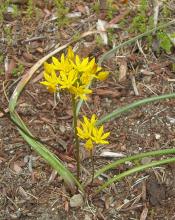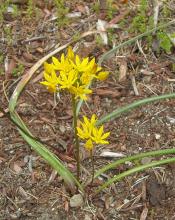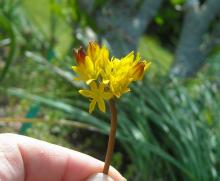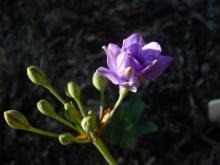I have a few North American bulbs now in bloom (mid-spring in the Southern Hemisphere);
Brodiaea terrestris from NARGS Seedex 2008 donated by Jane McGary, two shades are evident in this pot,
Brodiaea jolonensis, also from NARGS Seedex,
Dichelostemma ida-maia from bought bulbs last fall,
cheers
fermi
Comments
Mark,
Mark,
I've grown a few from NARGS Seedex seed and they've done well here.
This might be Dichelostemma pulchellum
and this might be D. multiflorum
and this could be Dichelostemma congestum
For some reason our little native bees seem to like sleeping in the flower heads (see first pic)!
cheers
fermi
Nice ones Fermi, gardeners
Nice ones Fermi, gardeners should try these more often. As I mentioned, I haven't grown any of the Dichelostemma, but do grow Trits and Brodiaeas. But I think I'll look for for Dichelostemma species on this years NARGS Seedex.
Mark,
Mark,
here's the Dichelostemma ida-maia with a few more flowers open
For some reason I've had this pot of Calochortus catalinae sitting in the Shade-house! It was just starting to open this morning,
cheers
fermi
Very nice, Fermi. I tried one
Very nice, Fermi. I tried one Calochortus from seed once and failed with it ( I think a few germinated and I killed them, but don't remember for sure) there are a couple that could be hardy here, if the moisture regimes are not too far off (my main moisture is early/mid-summer, sort of the opposite of most Pacific locales, even interior of B.C.), so I'll have to try again...
Hi Cohan,
Hi Cohan,
many of my calochortus have arrived as seed from the seedexes - primarily NARGS but also SRGC and AGS. (I know you can't restrict yourself to just one genus or just the rare ones but the cost of the seed is ridiculously low for the chance to try so many different types of plants - bulbs especially!) I'm sure to be requesting more calochortus when the lists roll around again - have another go, cohan!![]()
cheers
fermi
I definitely will have
I definitely will have another go at Calochortus- Alplains lists a few. I'm still not real member of anything, so it wont be seedex seed..lol
A few more from the garden,
A few more from the garden,
This is possibly Triteleia hyacinthina (can't remember what the seed was labelled as!)
This one is paler and growing in the rock garden where it is spreading a bit
cheers
fermi
I've just posted some pics of
I've just posted some pics of more Calochorti in the Calochortus thread.
Here's a pic of the Brodiaea terrestris that was planted out in the garden (it's a sister seedling to the one posted above)
cheers
fermi
This came as Brodiaea
This came as Brodiaea coronaria from ?NZAGS Seedex 2004 (?maybe NARGS 2011 - I'll have to check my book) the label wasn't clear.
It appears similar to Mary Sue Ittner's pic of B. terestris ssp terestris on the PBS wiki.
Anyone with more experience with these willing to sort it out?
cheers
fermi
Triteleia ixioides
Triteleia ixioides
A new cultivar for us of T. laxa 'Silver Queen' - just starting to come into bloom,
cheers
fermi
Small heartache seeing
Small heartache seeing Triteleia ixioides, I grew it for about 6 years, in two named formed, sorry that is no longer present in my garden :-(
One that is still with me, a rather small yellow-flowered one, is T. lemmoniae. Photos from 2010, but it pretty much looks the same every year. It barely increases for me, but I do have some younger seedling plants coming along, from scratching in seed near the mother plants. I like how the flowers get tinged brown when they start going over.
Some more Trites!
Some more Trites!
This is another of the selections available from David Glenn at Lambley Nursery (lambley.com.au) which he imported from Holland, Triteleia (?laxa) 'WWW'
And this is a single Triteleia laxa which may've been a stray corm or possibily a seedling from the main clump (I posted a pic in the "garden walks" Thread) and has come up opposite the mound where the others are growing,
This range of colorful "bulbs" this late in the year is very inspiring - Will has already decided that we'll be planting a lot more of them next year! The "firecrackers" are still providing a brilliant red even though most of the florets have turned upwards - presumably indicating that seed is set?
cheers
fermi
Brodiaea californica is
Brodiaea californica is making more of an impression as it goes!
Another new one for us is Triteleia laxa Royal Blue - just one flower open so far - in all its double glory!
cheers
fermi
All I can say Fermi, Trits &
All I can say Fermi, Trits & Brods must really love Australia! That clump of Brodiaea californica is glorious.
Mark,
Mark,
I have to admit that it's been building up over 10 years! Notwithstanding some removals to establish another colony in another bed (the first pic I posted) it hasn't really been disturbed in that time. I'm really getting keen on these American bulbs because they extend the bulb season into summer but it does mean they can't be grown under the deciduous trees like the earlier flowering tulips and daffs as they'll be shaded out. This clump is in full sun in the middle of a gentle north slope (that's like a south slope for you guys!) of our "CM" (Central Mound) in the main rock garden,
cheers
fermi
Not the best pic, I thought I
Not the best pic, I thought I'd post it anyway and hope for a better one as more flowers open; this is Bloomeria crocea,
cheers
fermi
It's not the most robust of
It's not the most robust of plants and the pic isn't the greatest but I like this Bloomeria crocea - maybe it would benefit from less competition from the Califronia Poppies and Alliums?
cheers
fermi
We visited our friend Cathy
We visited our friend Cathy this week and she had this Triteleia laxa in flower which I presume is the "original" T.laxa 'Queen Fabiola' which is a lot darker than the one sold under that name in the trade in Australia.
There are more Trits available and other American bulbs in two catalogues we've just received (sorry Australia only!) - Marcus Harvey's Hillview Rare Plants (hillviewrareplants.com.au) and Lambley Nursery (lambley.com.au)
cheers
fermi
PS I've just corrected the address for Marcus' list!
One of the Dichelostemmas
One of the Dichelostemmas
A new one in our garden is Triteleia 'Starlight' - I'm not sure if the stems are meant to be so short,
cheers
fermi
Seems Victoria, Australia is
Seems Victoria, Australia is a better place for growing North American bulbs than Norway!
This little Brodiaea or
This little Brodiaea or triteleia was a stray in another pot and this year has produced a montrous flower!
This Dichelostemma came to us as D. pulchellum
cheers
fermi
I think this was raised from
I think this was raised from NARGS Seedex seed as Dichelostemma multiflorum or D. capitatum - can't find the label!
cheers
fermi
Triteleia ixioides is lovely
Triteleia ixioides is lovely but does turn up where it shouldn't - like in this pot of seedlings raised as Bloomeria!
cheers
fermi
The Calochortus are starting!
The Calochortus are starting!
Calochortus pulchellus
Calochortus venustus
Calochortus clavatus ssp recurvifolius
cheers
fermi
Triteleia hyacinthina in the
Triteleia hyacinthina in the garden only managed one flowering stem; these were from a friend who sadly just passed away last week !
There were a couple in pots a week ahead of the ones in the garden (from another friend who grew them from seed from California as something else)
cheers
fermi
Some of the hybrids
Some of the hybrids/selections are in bloom now:
Triteleia 'Silver Queen'
Triteleia 'Allure'
cheers
fermi
This year's Bloomeria crocea
This year's Bloomeria crocea seems to be a repeat of 2013, even to the number of flowers!
cheers
fermi
Very pretty Fermi.
Very pretty Fermi.
This Calochortus flowered for
This Calochortus flowered for the first time last week. I managed to find a fragment of label which indicates that it's Calochortus clavatus grown from NARGS Seedex 2008,
cheers
fermi
Some of the "themids" in
Some of the "themids" in flower now:
Triteleia laxa
Triteleia (maybe) elegans - the label was not with these bulbs so I hope this where it should've gone!
cheers
fermi
Beautiful! I would love to
Beautiful! I would love to be able to grow these (in season, of course- there's snow on the ground here. ;-) )
This came as seed from NARGS
This came as seed from NARGS Seedex 2009 as Dichelostemma capitatum mix (Jane McGary).
The seedlings (31 out of 36 sown!) were divided and the the largest planted out - I'm not sure if they ever flowered. These were the smallest bulbs, kept potted and sadly not all have survived,
cheers
fermi
Our first Calochortus for the
Our first Calochortus for the year - Calochortus catalinae
Raised from seed from the 2008 NARGS Seedex
cheers
fermi
The first of the North
The first of the North American onions to bloom here,
Allium drummondii
Allium peninsulare
cheers
fermi
This was an "unlabeled bulb"
This was an "unlabeled bulb" - the closest label reads Brodiaea elegans but I presume is a Triteleia of some sort - possibly one of the T. laxa selections [ discovered the correct label - T.laxa 'The Giant' - seems appropriate!]
cheers
fermi
The Triteleia bridgesii was
The Triteleia bridgesii was very floriferous a week after the initial pic
Some Triteleia cultivars:
Allure
Rudy Kleiner
Silver Queen - the nearby Crataegus are getting bigger and these bulbs will have to be moved before long,
Dichelostemma ida-maia is already going to seed but the lower blooms are still fresh
These Triteleia laxa have obviously been setting seed as there is at least one which is an amethyst color!
cheers
fermi
A few more from earlier this
A few more from earlier this month:
Triteleia laxa 'Royal Blue' the only double I know of,
Triteleia 'WWW'
Brodiaea californica
cheers
fermi
Trilliums are not the easiest
Trilliums are not the easiest plants to grow in our climate.
This one came from our group's annual plant exchange in December 2007 and has produced its first flower this spring!
The label says Trillium sessile - can anyone confirm that?
cheers
fermi
very nice-thanks
very nice-thanks
Thanks, Harold,
Thanks, Harold,
someone else has suggested that it is Trillium chloropetalum rather than T. sessile.
I'm just glad to finally see it in flower!
cheers
fermi
From my admittedly limited
From my admittedly limited experience with trilliums, I thought that the leaves on the chloropetalum were more up-turned and the edges potentially more wavy than those of the sessile species.
Based solely on the photos, I would have made the ID as T. sessile.
Certainly there are folks that have a great deal more experience with Trilliums than I, so hopefully they can provide you with a more concrete identification.
I don't have an opinion for
I don't have an opinion for you, Fermi, and I am still unsure of what my "T. sessile" really is. I bought it as T. sessile, and never gave it a second thought until I dug it up to divide it, and discovered the rhizome was not horizontal as it is supposed to be. My plant had several offsets, tightly held against the mother "bulb".
A friend sent me some plants of wild T. sessile and T. cuneatum from Illinois, which also has horizontal rhizomes.
Cuneatum had what I envisioned would be the typical horizontal growth:
But then I saw what he sent me as T. sessile:
They certainly looked vertical to me, but upon closer inspection I saw the horizontal rhizome:
It seems one of the better ways to distinguish species is with stamen and ovary characteristics, but the root configuration will certainly help. Not that you should dig yours up, but if you remember what it was like when you planted it, or for future reference.
The "themids" are in flower
The "themids" are in flower in our Southern Hemisphere garden.
Triteleia terrestris
Triteleia ixioides
cheers
fermi
I found a packet of corms of
I found a packet of corms of Triteleia (?laxa) 'Allure' which had been missed when planting out bulbs last fall![]()
So they were planted in October when others of their clan were already in flower. Surprisingly not only did they grow but they have now come into flower![]()
cheers
fermi









Brodiaea and Trits (Triteleia) are good doers here, should be grown more often, really lovely bulbs. Unfortunately the Firecracker Flower, Dichelostemma ida-maia, is not hardy here, I've tried. Some of the other Dichelostemmas might be hardy enough, but those I have not tried.